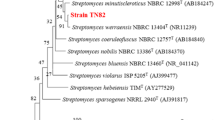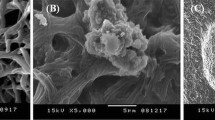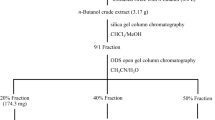Abstract
A new actinomycete strain designated TN256, producing antimicrobial activity against pathogenic bacteria and fungi, was isolated from a Tunisian Saharan soil. Morphological and chemical studies indicated that strain TN256 belonged to the genus Streptomyces. Analysis of the 16S rDNA sequence of strain TN256 showed a similarity level ranging between 99.79 and 97.8% within Streptomyces microflavus DSM 40331T and Streptomyces griseorubiginosus DSM 40469T respectively. The comparison of its physiological characteristics showed significant differences with the nearest species. Combined analysis of the 16 S rRNA gene sequences (FN687758), fatty acids profile, and results of physiological and biochemical tests indicated that there were genotypic and phenotypic differentiations of that isolate from other Streptomyces species neighbours. These date strongly suggest that strain TN256 represents a novel species with the type strain Streptomyces TN256 (=CTM50228T). Experimental validation by DNA–DNA hybridization would be required for conclusive confirmation. Four active products (1–4) were isolated from the culture broth of Streptomyces TN256 using various separation and purification steps and procedures. 1: N-[2-(1H-indol-3-yl)-2 oxo-ethyl] acetamide ‘alkaloid’ derivative; 2: di-(2-ethylhexyl) phthalate, a phthalate derivative; 3: 1-Nonadecene and 4: Cyclo (l-Pro-l-Tyr) a diketopiperazine ‘DKP’ derivative. The chemical structure of these four active compounds was established on the basis of spectroscopic studies NMR and by comparing with data from the literature. According to our biological studies, we showed in this work that the pure compounds (1–4) possess antibacterial and antifungal activities.





Similar content being viewed by others
References
Al-Bari MAA, Abu Sayeed M, Rahman MS, Mossadik MA (2006) Characterization and antimicrobial activities of a phthalic acid derivative produced by Streptomyces bangladeshiensis a novel species collected in Bangladesh. Res J Medicinal Med Sci 1:77–81
Athalye M, Goodfellow M, Lacey J, White RP (1985) Numerical classification of Actinomadura and Nocardiopsis. Int J Syst Evol Microbiol 35:86–98
Ben Ameur Mehdi R, Mellouli L, Chabchoub F, Fotso S, Bejar S (2004) Purification and structure elucidation of two biologically active molecules from a new isolated Streptomyces sp. US24 strain. Chem Nat Comp 40:510–513
Ben Ameur Mehdi R, Sioud S, Fourati Ben Fguira L, Bejar S, Mellouli L (2006) Purification and structure determination of four bioactive molecules from a newly isolated Streptomyces sp. TN97 strain. Process Biochem 41:1506–1513
Chatterjee S, Vijayakumar EK, Franco CM, Maurya R, Blumbach J, Ganguli BN (1995) Phencomycin, a new antibiotic from a Streptomyces species HIL Y-9031725. J Antibiot (Tokyo) 48:1353–1354
Collins MD, Jones D (1980) Lipids in the classification and identification of coryneform bacteria containing peptidoglycan based on 2, 4-diaminobutyric acid. J Appl Bacteriol 48:459–470
Covan ST, Steel KJ (1974) Manual for identification of medical bacteria. Cambridge University Press, Cambridge
Edwards U, Rogall T, Blöcker H, Emde M, Böttger EC (1989) Isolation and direct complete nucleotide determination of entire genes. Characterization of a gene coding for 16S ribosomal RNA. Nucleic Acids Res 17:7843–7853
Elleuch L, Shaaban M, Smaoui S, Mellouli L, Karray-Rebai I, Fourati Ben Fguira L, Shaaban KA, Laatsch H (2010) Bioactive secondary metabolites from a new terrestrial Streptomyces sp. TN262. Appl Biochem Biotechnol 162:579–593
El-Naggar MYM (1997) Dibutyl phthalte and the antitumor agent F5A1, two metabolites produced by Streptomyces nasri submutant H35. Biomed Lett 55:125–131
El-Sakhawy FS, El-Tantawy ME, Ross SA, El-Sohly MA (1998) Composition and antimicrobial activity of the essential oil of Murraya exotica. Flavour Frag J 13:59–62
Felsentein J (1985) Confidence limits on phylogenies: an approach using the bootstrap. Evolution 39:783–791
Ge Y, Huang X, Wang S, Zhang X, Xu Y (2004) Phenazine-1- carboxylic acid is negatively regulated and pyoluteorin positively regulated by gacA in Pseudomonas sp. M18. FEMS Microbiol Lett 237:41–47
Gebhardt K, Schimana J, Krastel P, Dettner K, Rheinheimer J, Zeeck A, Fiedler H (2002) Endophenazines A-D, New phenazine antibiotics from the arthropod associated endosymbiont Streptomyces anulatus. Taxonomy, fermentation, isolation and biological activities. J Antibiot (Tokyo) 55:794–800
Gordon RE, Barnett DA (1977) Resistance to rifampin and lysozyme of strains of some species of Mycobacterium and Nocardia as a taxonomic tool. Int J Syst Evol Microbiol 27:176–178
Gordon RE, Barnett DA, Handarhan JE, Hor-Nay-Pang C (1974) Nocardia coeliaca, Nocardia autotrophica and the nocardin strains. Int J Syst Evol Microbiol 24:54–63
Hopwood DA, Bibb MJ, Chater KF, Kieser T, Bruton CJ, Kieser HM, Lydiate DJ, Smith CP, Ward JM, Schremph H (1985) Genetic manipulation of Streptomyces: a laboratory manual. John Innes Foundation, Norwich
Kenneth LK (1958) Prepared research paper RP 2911, central natations for the revised ISCC-NBS color name blocks. J Res NBS 16:427
Kim SB, Goodfellow M (2002) Streptomyces avermitilis sp. nov., a taxonomic home for the avermectin-producing streptomycetes. Int J Syst Evol Microbiol 52:2011–2014
Kroppenstedt RM (1985) Fatty acid and menaquinone analysis of actinomycetes and related organisms. In: Goodfellow M, Minnikin DE (eds) Chemical methods in bacterial systematics. Academic Press, London, pp 173–199
Kroppenstedt R, Stackebrandt EM, Goodfellow M (1990) Taxonomic revision of the actinomycete genera Actinomudura and Microtetruspora. Syst Appl Microbiol 13:148–160
Lanoot B, Vancanneyt M, Dawyndt P, Crockaert M, Zhang J, Huang Y, Liu Z, Swings J (2004) BOX-PCR fingerprinting as a powerful tool to reveal synonymous names in the genus Streptomyces. Emended descriptions are proposed for the species Streptomyces cinereorectus, S. fradiae, S. tricolor, S. columbiensis, S. filamentosus, S. vinaceus and S. phaeopurpureus. Syst Appl Microbiol 27:84–92
Lechevalier MP, Lechevalier HA (1970a) Composition of whole-cell hydrolysates as a criterion in the classification of aerobic actinomycetes. In: Prauser H (ed) The Actinomycetales. G. Fisher Verlag, Jena, pp 311–316
Lechevalier HA, Lechevalier MP (1970b) A critical evaluation of genera of aerobic actinomycetes. In: Prauser H (ed) The Actinomycetales. G. Fisher Verlag, Jena, pp 393–405
Lee KH, Kim JH, Lim DS, Kim CH (2000) Anti-leukaemic and antimutagenic effects of di (2-ethylhexyl) phthalate isolated from Aloe linne. J Pharm Pharmacol 52:593–598
Liu Z, Shi Y, Zhang Y, Zhou Z, Lu Z, Li W, Rodriguez C, Goodfellow M (2005) Classification of Streptomyces griseus (Krainsky 1914) Waksman and Henrici 1948 and related species and the transfer of ‘Microstreptospora cinerea’ to the genus Streptomyces as Streptomyces yanii sp. nov. Int J Syst Evol Microbiol 55:1605–1610
Magyar A, Zhang X, Abdi F, Kohn H, Widger W (1999) Identifying the bicyclomycin binding domain through biochemical analysis of antibiotic-resistant Rho proteins. J Biol Chem 274:7316–7324
Makhija SN, Vavia PR (2003) Controlled porosity osmotic pump-based controlled release systems of pseudoephedrine I. Cellulose acetate as a semipermeable membrane. J Control Release 89:5–18
Marchetti L, Sabbieti MG, Menghi M, Materazzi S, Hurley MM, Manghi G (2002) Effects pf phtalate esters on actin cytoskeleton of Py1a rat osteoblasts. Histol Histopathol 17:1061–1066
Mellouli L, Ameur Mehdi RB, Sioud S, Salem M, Bejar S (2003) Isolation, purification and partial characterization of antibacterial activities produced by a newly isolated Streptomyces sp. US24 strain. Res Microbiol 154:345–352
Minnikin DE, Collins MD, Goodfellow M (1979) Fatty acid and polar lipid composition in the classification of Cellulomonas, Oerskovia and relatedtaxa. J Appl Bacteriol 47:87–95
Miyadoh S (1993) Research on antibiotic screening in Japan over the last decade: a producing microorganisms approach. Actinomycetologica 7:100–106
Pusecker K, Laatsch H, Helmke E, Weyland H (1997) Dihydrophencomycin methyl ester, a new phenazine derivative from a marine Streptomycete. J Antibiot 50:479–483
Rhee KH (2002) Isolation and characterization of Streptomyces sp. KH-614 producing anti-VRE (vancomycin-resistant enterococci) antibiotics. J Gen Appl Microbiol 48:321–327
Roy RN, Laskar S, Sen SK (2006) Dibutyl phthalate, the bioactive compound produced by Streptomyces albidoflavus 321.2. Microbiol Res 161:121–126
Saitou N, Nei M (1987) The neighbour-joining method: a new method for reconstructing phylogenetic tree. Mol Biol Evol 4:406–425
Sambrook JE, Fritsh EF, Maniatis T (1989) Molecular cloning: a laboratory manual. Cold Spring Harbor Laboratory, Cold Spring Harbor, NY
Sasser M (1990) Identification of bacteria by gas chromatography of cellular fatty acids. USFCC Newslett 20:1–6
Shirling EB, Gottlieb D (1966) Methods for characterization of Streptomyces species. Int J Syst Bacteriol 16:313–340
Sierra G (1957) A simple method for the detection of lipolytic activity of microorganisms and some observations on the influence of the contact between cells and fatty substrates. Anton Leeuw Int J G 23:15–22
Staneck JL, Roberts GD (1974) Simplified approach to the identification of aerobic actinomycetes by thin-layer chromatography. Appl Microbiol 28:226–231
Thompson JD, Gibson TJ, Plewniak F, Jeanmougin F, Higgins DG (1997) The Clustal X windows interface: flexible strategies for multiple sequence alignment aided by quality analysis tools. Nucleic Acids Res 24:4876–4888
Tsukamura M (1966) Adansonian classification of mycobacteria. J Gen Microbiol 45:253–273
Vining LC (1992) Secondary metabolism, inventive evolution and biochemical diversity-a review. Gene 115:135–140
Voelker F, Altaba S (2001) Nitrogen source governs the patterns of growth and pristinamycin production in ‘Streptomyces pristinaespiralis’. Microbiology 147:2447–2459
Watve MG, Tickoo R, Jog MM, Bhole BD (2001) How many antibiotics are produced by the genus Streptomyces? Arch Microbiol 176:386–390
Williams ST, Cross T (1971) Isolation, purification, cultivation and preservation of actinomycetes. Methods Microbiol 4:295–334
Williams ST, Goodfellow M, Alderson G, Wellington EMH, Sneath PHA, Sackin MJ (1983) Numerical classification of Streptomyces and related genera. J Gen Microbiol 129:1743–1813
Williams ST, Sharpe ME, Holt JG (1989) Bergey’s manual of systematic bacteriology, vol 4. Williams and Wilkins Company, Baltimore
Yassa N, Masoomi F, Rohani Rankouhi SE, Hadjiakhoondi A (2009) Chemical composition and antioxidant activity of the extract and essential oil of Rosa damascena from Iran, population of Guilan. DARU 3:175–180
Acknowledgments
This work was supported by the CMCU project No: 06/S 0901 “MELLOULI/AIGLE” 2006–2009.
Author information
Authors and Affiliations
Corresponding author
Rights and permissions
About this article
Cite this article
Smaoui, S., Mathieu, F., Elleuch, L. et al. Taxonomy, purification and chemical characterization of four bioactive compounds from new Streptomyces sp. TN256 strain. World J Microbiol Biotechnol 28, 793–804 (2012). https://doi.org/10.1007/s11274-011-0872-6
Received:
Accepted:
Published:
Issue Date:
DOI: https://doi.org/10.1007/s11274-011-0872-6




